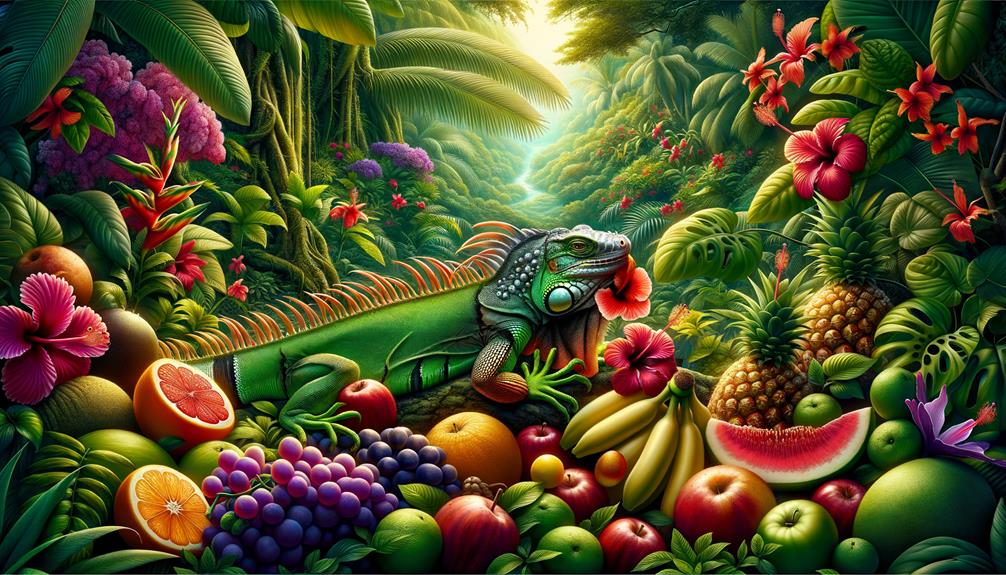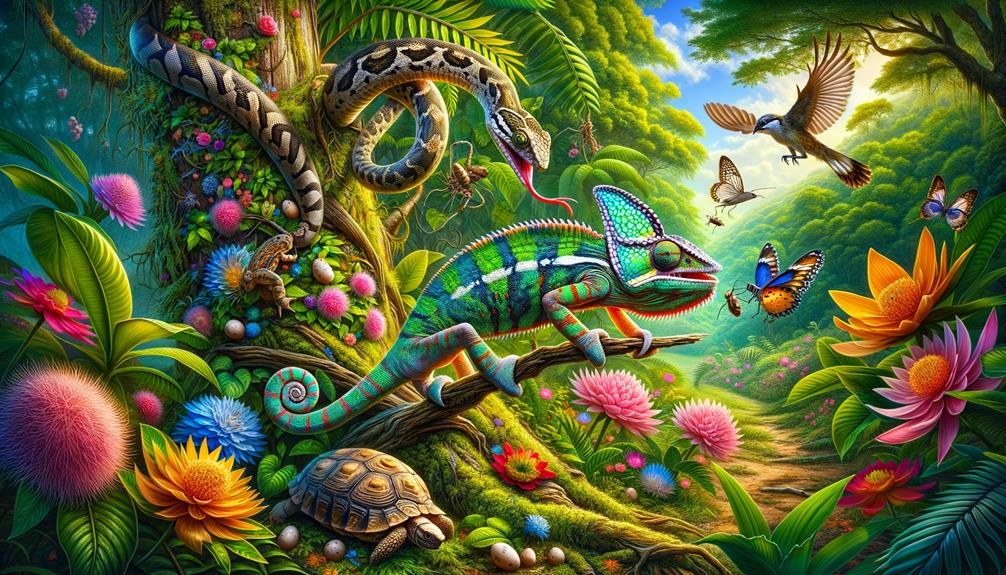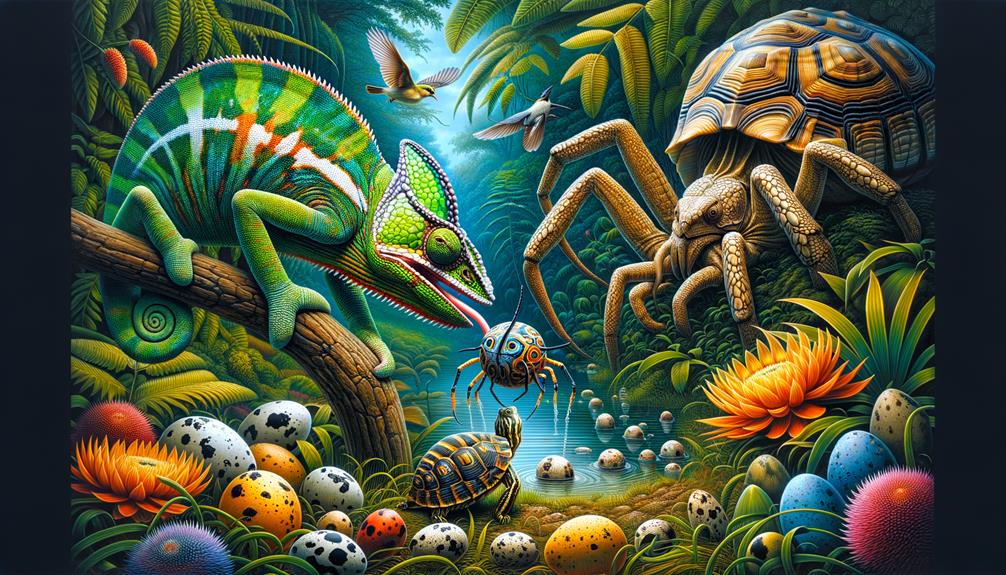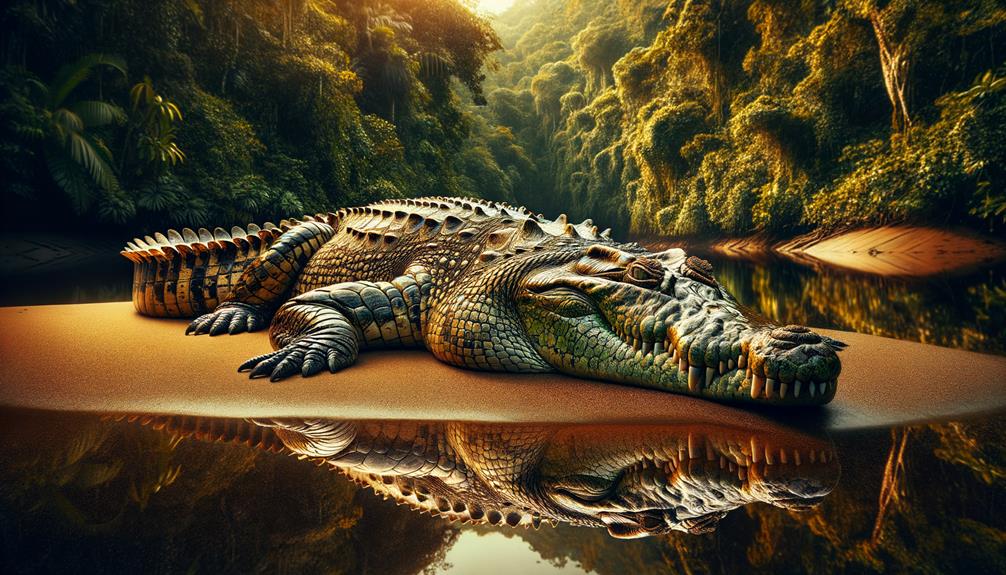I've found that many reptiles have truly unique eating habits. The Galápagos marine iguanas, for instance, primarily feast on seaweed, while Blunthead Tree Snakes in South America have a specialized taste for snails. Chuckwallas from the southwestern US have a clever defense mechanism – they inflate their bodies to deter predators while munching on plants. Kingsnakes, on the other hand, are fearless predators that prey on other snakes, including venomous species. Reticulated Pythons and Green Anacondas are capable of subduing massive prey like deer and caimans. These varied diets showcase the remarkable adaptability and evolutionary ingenuity of reptiles. Let's explore more about these fascinating dietary habits.
Key Takeaways
<|start_header_id|>
Carnivorous Reptiles
When exploring the world of carnivorous reptiles, we find a fascinating array of species that employ diverse hunting techniques and prey on a wide variety of animals. Take the Reticulated Python, for instance. These massive snakes are known for consuming large prey, including deer and wild boar. They use constriction to subdue their targets, coiling around them and squeezing until the prey can no longer breathe. This method is both efficient and deadly, allowing the python to tackle animals much larger than itself.
Monitor lizards are versatile hunters with a broad diet that includes live insects, small mammals, and even other reptiles. They utilize both ambush tactics and active pursuit, showcasing remarkable adaptability. Their hunting strategies are as varied as their prey, making them formidable predators in their habitats.
Crocodiles stand out as apex predators, capable of capturing and consuming a range of animals, from fish and birds to larger mammals – and occasionally, even humans. Their dominance in the food chain highlights the incredible adaptability and strength that carnivorous reptiles possess.
Herbivorous Oddities

While carnivorous reptiles dominate the predatory landscape, there are some fascinating exceptions that showcase the adaptability of these creatures. Take the marine iguanas of the Galápagos Islands, the only reptiles that feed primarily on seaweed. These unique iguanas dive into the ocean to graze on algae, a behavior that sets them apart from their terrestrial relatives.
In the scorching deserts of the southwestern United States and northern Mexico, the chuckwalla thrives on a diet of leaves, flowers, and fruit. This large herbivorous lizard can inflate itself with air to deter predators, a remarkable survival tactic.
In the lush canopies of Central and South America, we find the green iguana. These arboreal reptiles feast on a variety of plant matter, from tender leaves to ripe fruits, making them a vibrant part of their ecosystems.
Spiny-tailed agamas, native to North Africa and Southwest Asia, have developed another fascinating survival strategy. They store fat in their tails, ensuring they can endure periods of food scarcity.
Even in the dense forests of Madagascar, the parrot-beaked reptile demonstrates resilience. Its beak-like jaw allows it to munch on tough, woody plants.
From New York terrariums housing Crested Geckos to wild habitats around the globe, these herbivorous reptiles highlight the incredible diversity of reptilian diets.
Specialized Diets

Specialized diets in reptiles showcase their incredible adaptability and evolutionary ingenuity, demonstrating how they've mastered unique niches in their ecosystems. The blunthead tree snake, found in South America, has a remarkable diet consisting solely of snails, allowing it to thrive where other predators might struggle. In North Africa's arid regions, certain reptiles have developed unique feeding habits, illustrating their ability to adapt to challenging environments.
The kingsnake, for instance, preys on other snakes, including venomous species like young rattlesnakes. This dietary flexibility reduces competition and provides a steady food source. Pythons and boas, native to various continents, including parts of North Africa, showcase their adaptability by consuming large prey, such as massive lizards and small mammals. Their ability to consume such large prey items speaks to their evolutionary success.
Sea turtles, with their specialized diets of ocean plants and jellyfish, highlight how marine reptiles have evolved to exploit the abundant resources of their aquatic habitats. The yellow-footed tortoise of South America adds variety to its herbivorous diet by consuming crayfish and other invertebrates, illustrating the diverse feeding strategies reptiles employ to survive and thrive.
Unusual Prey

In the field of herpetology, there are documented cases of snakes consuming unusual prey items like sticks, bones, and even metal objects, which reveal fascinating deviations from their typical diets. These instances highlight the broad range of prey that members of this group can encounter and sometimes mistakenly consume. For instance, green anacondas don't just eat small mammals and fish; they've also been known to eat other anacondas, spectacled caimans, turtles, and even deer.
A particularly intriguing case involved a coachwhip snake in Arizona that was seen biting and swallowing a tree branch, likely mistaking it for a fence lizard due to its similar appearance. Such mistakes provide insight into the sensory and cognitive processes of these reptiles. Another striking example is a northern scarlet snake found consuming a young, dead corn snake. Meanwhile, a southern hognosed snake was documented eating an ox beetle grub, demonstrating their ability to adapt their diet to available resources.
These unusual dietary habits underscore the adaptability of snakes and their willingness to explore a diverse range of prey. By observing these occurrences, we can gain a better understanding of the ecological roles and survival strategies of these fascinating reptiles.
Adaptations for Feeding
Reptiles have developed remarkable adaptations for feeding that enable them to thrive in diverse environments and exploit a wide range of food sources. Throughout their evolution, these creatures have acquired features like powerful jaws, venom, and constriction abilities. Take the Green Anaconda, for example, with its impressive constriction technique. It can subdue large prey, such as capybaras and caimans, by wrapping its muscular body around them and squeezing until they can no longer breathe.
Snakes, in general, can unhinge their jaws to swallow prey much larger than their heads. This adaptation is crucial for species that encounter infrequent but substantial meals. Monitor lizards, on the other hand, use their long, forked tongues to detect and track small animals, demonstrating the diversity in reptilian feeding strategies.
Herbivorous reptiles like iguanas and tortoises have developed specialized digestive systems to break down tough plant material. These systems often allow them to supplement their diet with small invertebrates, ensuring they get adequate nutrition. Meanwhile, sea turtles and marine iguanas have adapted to underwater foraging, feeding on aquatic vegetation and algae. The diversity in feeding adaptations among reptiles is a testament to their remarkable adaptability.
Frequently Asked Questions
Are There Any Vegetarian Reptiles?
Here's a rewritten version of the text:
Some reptiles are vegetarians. Take land tortoises, green iguanas, and chuckwallas, for example. These species only eat plants, and their unique adaptations highlight the diverse range of diets within the reptile family.
What Can Lizards Not Eat?
I once saw a lizard struggle to swallow a large cricket, which drove home the importance of avoiding oversized prey. It's also crucial to keep certain toxic foods out of their diet, including rhubarb leaves, onions, garlic, wild-caught insects, fatty foods, chocolate, caffeine, and alcohol.
Do All Reptiles Eat the Same Thing?
Reptiles have diverse diets, and they don't all eat the same thing. Some are plant-eaters, while others are meat-eaters, and some consume both plants and animals. This adaptability allows them to thrive in various environments and ecological niches.
What Is the Diet of Reptiles?
Reptile diets vary greatly, from carnivores that feed on insects and mammals to herbivores that eat leaves and grass. Marine iguanas snack on seaweed, while large snakes prey on pigs and deer.



